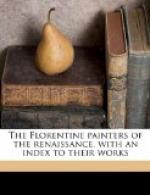[Page heading: ORCAGNA]
Of Orcagna it is difficult to speak, as only a single fairly intact painting of his remains, the altar-piece in S. Maria Novella. Here he reveals himself as a man of considerable endowment: as in Giotto, we have tactile values, material significance; the figures artistically exist. But while this painting betrays no peculiar feeling for beauty of face and expression, the frescoes in the same chapel, the one in particular representing Paradise, have faces full of charm and grace. I am tempted to believe that we have here a happy improvement made by the recent restorer. But what these mural paintings must always have had is real artistic existence, great dignity of slow but rhythmic movement, and splendid grouping. They still convince us of their high purpose. On the other hand, we are disappointed in Orcagna’s sculptured tabernacle at Or Sammichele, where the feeling for both material and spiritual significance is much lower.
[Page heading: FRA ANGELICO]
We are happily far better situated toward Fra Angelico, enough of whose works have come down to us to reveal not only his quality as an artist, but his character as a man. Perfect certainty of purpose, utter devotion to his task, a sacramental earnestness in performing it, are what the quantity and quality of his work together proclaim. It is true that Giotto’s profound feeling for either the materially or the spiritually significant was denied him—and there is no possible compensation for the difference; but although his sense for the real was weaker, it yet extended to fields which Giotto had not touched. Like all the supreme artists, Giotto had no inclination to concern himself with his attitude toward the significant, with his feelings about it; the grasping and presentation of it sufficed him. In the weaker personality, the significant, vaguely perceived, is converted into emotion, is merely felt, and not realised. Over this realm of feeling Fra Angelico was the first great master. “God’s in his heaven—all’s right with the world” he felt with an intensity which prevented him from perceiving evil anywhere. When he was obliged to portray it, his imagination failed him and he became a mere child; his hells are bogy-land; his martyrdoms are enacted by children solemnly playing at martyr and executioner; and he nearly spoils one of the most impressive scenes ever painted—the great “Crucifixion” at San Marco—with the childish violence of St. Jerome’s tears. But upon the picturing of blitheness, of ecstatic confidence in God’s loving care, he lavished all the resources of his art. Nor were they small. To a power of rendering tactile values, to a sense for the significant in composition, inferior, it is true, to Giotto’s, but superior to the qualifications of any intervening painter, Fra Angelico added the charm of great facial beauty, the interest of vivid expression, the attraction of delicate colour. What in the whole world of




